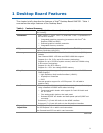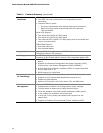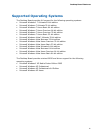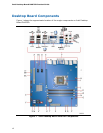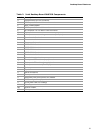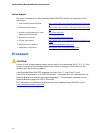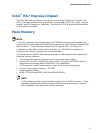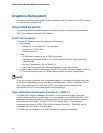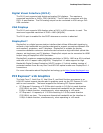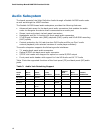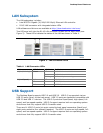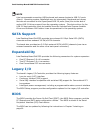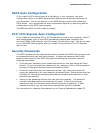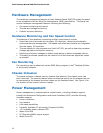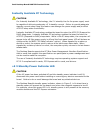
Desktop Board Features
17
Digital Visual Interface (DVI-I)
The DVI-I port supports both digital and analog DVI displays. The maximum
supported resolution is 1900 x 1200 (WUXGA). The DVI port is compliant with the
DVI 1.0 specification. The DVI analog output can be converted to VGA using a DVI-
VGA converter.
VGA Displays
The DVI-I port supports VGA displays when a DVI-I to VGA converter is used. The
maximum supported resolution is 2560 x 1600 (WQXGA).
The DVI-A port is enabled for the POST whenever a monitor is attached.
DisplayPort*
DisplayPort is a digital communication interface that utilizes differential signaling to
achieve a high bandwidth bus interface designed to support connections between PCs
and monitors, projectors, and TV displays. DisplayPort is suitable for display
connections between consumer electronics devices such as high definition optical disc
players, set top boxes, and TV displays. DisplayPort output can be converted to HDMI
output using a DisplayPort-HDMI converter.
DisplayPort’s maximum supported display resolution is 2560 x 1600 at a 60 Hz refresh
rate with a 16:10 aspect ratio (WQXGA). DisplayPort 1.1 adds support for High
Bandwidth Digital Content Protection (HDCP) version 1.3 which enables viewing of
protected content from Blu-ray Disc* and HD-DVD optical media over DisplayPort 1.1
connections.
For more information about DisplayPort technology go to http://www.displayport.org
.
PCI Express* x16 Graphics
The Intel Core i7, Intel Core i5, Intel Core i3, and Intel Pentium processors in an
LGA1155 socket support discrete add-in graphics cards via the PCI Express 2.0 x16
add-in card connector. The board supports the following PCI Express speeds:
• PCI Express 2 frequency of 2.5 GHz which results in 5.0 Gb/s in each direction
(500 MB/s) per lane. The maximum theoretical bandwidth on the interface is
8 GB/s in each direction, simultaneously, when operating in x16 mode.
• PCI Express 1.1 frequency of 1.25 GHz resulting in 2.5 Gb/s each direction
(250 MB/s) per lane. The maximum theoretical bandwidth on the interface is
4 GB/s in each direction, simultaneously, when operating in x16 mode.



